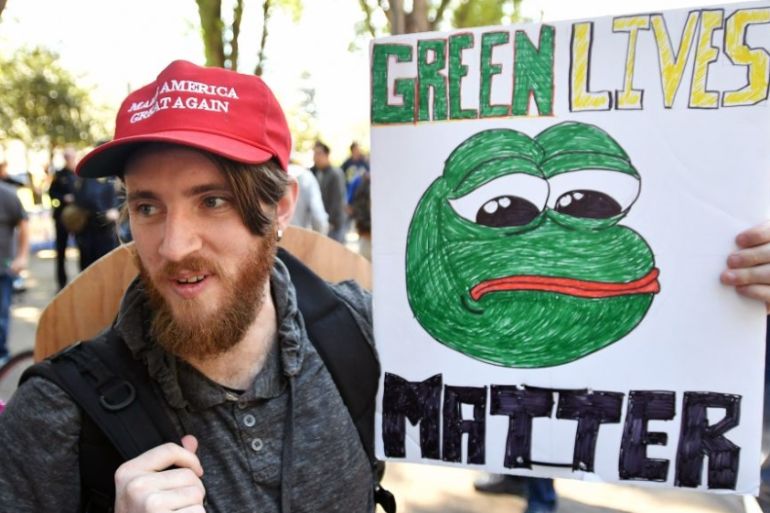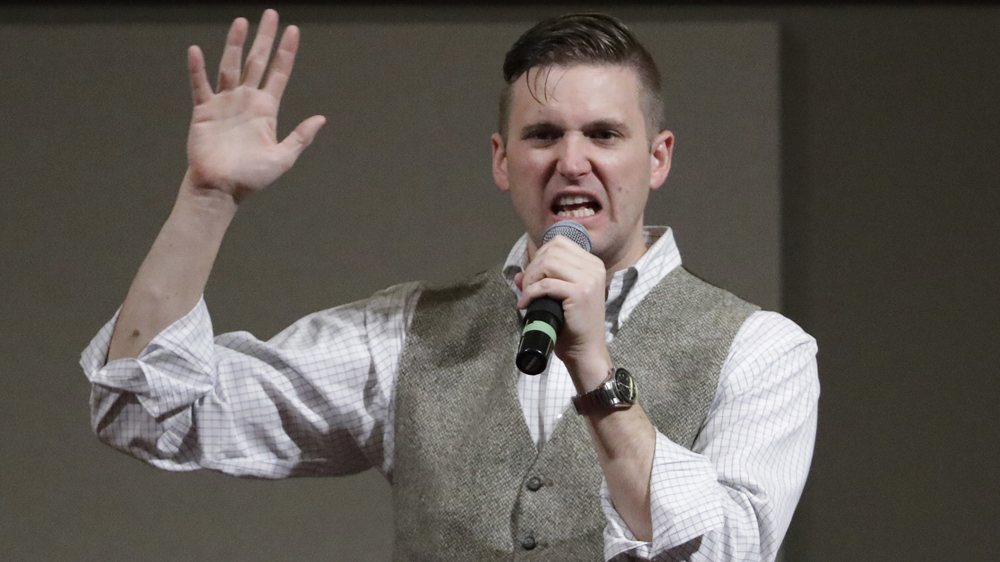A brief dictionary to help understand the US far right
Al Jazeera breaks down some of the most important phrases, terms and numerology that are used by the far right online.

The campaign and election of US President Donald Trump have emboldened the country’s far-right movement, which celebrated his policies designed to limit immigration and repeal affirmative action, among others.
Among those groups is the alt-right, a loosely knit coalition of white supremacists, white nationalists and neo-Nazis.
Keep reading
list of 4 items‘No means no’: How Portugal resisted the far right, but only just
Germany bans far-right Austrian nationalist Martin Sellner from entry
Australian efforts on Islamophobia flag despite Christchurch wake-up call
|
|
With the simultaneous rise of anti-fascist groups across the country, the alt-right and others on the far right have focused their efforts on building a strong street presence, holding several rallies and marches in states like California, Oregon and Virginia.
These efforts culminated in the “Unite the Right” rally in Charlottesville, Virginia, on August 12.
Hundreds of white supremacists and neo-Nazis travelled to Charlottesville to protest against the city’s decision to remove a statue of Robert E Lee, the Confederacy’s foremost military leader during the US Civil War (1861-1865).
Unite the Right participants descended on Charlottesville and clashed with community members, anti-racist activists and anti-fascists.
By the end of the day, James Alex Fields, a 20-year-old Ohio resident who had been photographed marching with neo-Nazis earlier in the day, allegedly murdered 32-year-old Heather Heyer, an anti-racist protester, and injuring several others when he rammed his car into a counterprotest.
Yet, long before the far right was flooding the streets of cities and towns across the US, the movement was building itself up on social media, online forums and in private chatrooms.
READ MORE: What is the alt-right and what does it stand for?
Much of the online lingo these groups employ is hard to decipher. Far-right users on Twitter and Facebook often speak in code, using an elaborate concoction of slang, coded language, memes and irony.
Al Jazeera has broken down some of the most important phrases, terms and numerology that is rampant on among far-right users of social media and online forums.
A brief dictionary
12: A number often used as the numeric symbol for the Aryan Brotherhood, a white supremacist prison gang. The number one represents the first letter of the alphabet, “A”, and the number two represents “B”.
1488: A popular number among neo-Nazi groups. The first two numbers, 14, refer to the 14 words, a slogan made popular in the 1980s by David Lane, a white supremacist and founder of a violent organisation known as The Order. The phrase is as follows: “We must secure the existence of our people and a future for white children.”
Because “H” is the eighth letter of the alphabet, 88 is code for “Hail Hitler”, referring to Adolf Hitler, the German chancellor who presided over the Third Reich and carried out the Holocaust.
2316: The combination of the alphabet’s 23rd letter, “w”, with the 16th letter, “p”, means “white power”. The number is popular among many white supremacist groups, particularly in prisons.
6 Gorillion: While most scholars and experts agree that six million Jews were murdered in the Holocaust, white supremacists and neo-Nazis often use this fictional number – 6 Gorillion – to suggest that the number is exaggerated.
Alt-light: A term used to describe far-right nationalists who share many opinions of white supremacists and neo-Nazis, while often eschewing or rejecting labelling themselves as such or promoting openly anti-Semitic rhetoric.
Alt-right: A term that is short for “alternative right”. It was coined by white supremacist Richard Spencer in 2008, alt-right now refers to a loosely-knit movement of white supremacists, white nationalists and neo-Nazis.

Anti-white: Many far-right figures, particularly those in the alt-right, accuse anti-racists and anti-fascists of simply being “anti-white”, or hating white people simply because they are white.
Anudda Shoah: A phrase used to mock Jews who allege anti-Semitism. This phrase is particularly popular on the alt-right. The insinuation is that Jews claim they are at constant risk of enduring another “Shoah”, the Yiddish and Hebrew word for “Holocaust”.
Cuck: A term used to describe a man who watches other men have sexual relations with his wife or partner. Many on the alt-right use this term cast doubt on one’s masculinity and to describe white people who they claim betray their race.
Cuckservative: A combination of “cuck” and “conservative”. This refers to mainstream conservatives, such as establishment Republican Party members, who the far right view as establishment sellouts on issues like race and immigration.
Cultural Enrichment: A term used ironically to refer to the problems white supremacists, racists and others on the far right view as integral to immigration.
“Cultural enrichment” is often used to refer to crimes like rape or robbery when the suspect or assailant is from a religious or ethnic minority group.
Cultural Marxism: A catch-all label that the far right uses for most things they oppose, such as gender equality, anti-racism, support for Muslims’ civil rights and Affirmative Action.
“Cultural Marxism” has its roots in an anti-Semitic conspiracy theory which purports that Jewish Marxists from the Frankfurt School attempted to use leftist political ideology to undermine American society.
Echoes: This refers to placing three or more parentheses around a name to signify that the person is of Jewish ancestry. Many alt-right social media users use echoes on Twitter, Facebook and anonymous online forums.
Electric Jew: Owing to the conspiracy theory that Jews control the media, white supremacists often refer to the television as an “electric Jew”.
Fash: Short for “fascist”, this term is often used ironically among alt-rightists.
READ MORE: Alt-right weakened but not dead after Charlottesville
Gamergate: An online harassment campaign that targeted journalists who report on the gaming industry. Much of the harassment targeted female journalists and was openly misogynistic and sexist.
Gamergate is often described as a precursor to the rise of the alt-right.
Goy: The Hebrew and Yiddish term used for non-Jews. Alt-right and far-right adherents often ironically use the word “goy” to refer to themselves and other non-Jews.
Hand rubbing: A reference to an anti-Semitic cartoon depiction of a Jewish man rubbing his hands. This conspiratorial phrase is used to imply that Jews are controlling world events from behind the scenes.
JQ: This acronym is short for “Jewish Question”, or an anti-Semitic discourse over the role of Jews in society. As a concept, the Jewish Question can be traced back to the 19th century.
The phrase is often accompanied with conspiracies that Jews control the media, banks, politics and the economy.
Kek: This phrase refers to a fictional god. However, many alt-rightists and neo-Nazis have used to “Kek” to mean “kill every k*ke”.
Kekistan: This is a fictional country based on the phrase “kek”. In some online forums, such as the anonymous posting board 4chan, white supremacists say “Kekistan” is an acronym for “kill every k*ke, immediately start the Aryan nation”.
![In New York City, an alt-right protester carries the Kekistan flag [Pacific Press/Getty Images]](/wp-content/uploads/2017/10/cf112f8c7b534fc691dfb47d2562cc5c_18.jpeg)
Love Your Race: This phrase urges white people to embrace and find pride in their race. It was originally popularised by the National Alliance, according to the Anti-Defamation League.
Milk Nationalism: This term became popular on social media outlets, particularly Twitter, after a group of far rightists chugged milk as they hijacked actor Shia Labeouf’s anti-Trump art installation in New York City.
Many white supremacists, including the alt-right’s Richard Spencer, later put milk emojis on their Twitter profile biographies.
Some far-right figures online promoted debunked racial science theories that suggest people of European ancestry are better suited to digest dairy. Others claimed the alt-right was using Milk Nationalism to ironically to troll media outlets.
Normie: A pejorative label for a person who is part of mainstream culture. The term is often used to denote people who are not part of the alt-right.
Pepe: A cartoon frog often used in memes posted by white supremacist, anti-Semitic and racist social media users.
Pepe the Frog was created by artist Matt Furie for his 2005 comic strip Boy’s Club and became popular on the internet.
Although Furie has spoken out against the alt-right, the white supremacists and neo-Nazis have turned the frog into their unofficial mascot, often pairing Pepe memes with intense anti-Semitism, racism and calls for violence.
Race Traitor: A pejorative that targets someone with the accusation that they are disloyal to their own race. It is often used by white supremacists to describe white anti-racists or people who are in biracial romantic or platonic relationships.
RaHoWa: Credited to the late white supremacist Ben Klasser, “RaHoWa” means “racial holy war”. In a 1987 book titled RaHoWa – This Planet is Ours, Klassen described an apocalyptic war in which whites battle Jews and people of colour.
Rapefugee: A racist slur used to describe refugees and migrants. White supremacists often claim that refugees – particularly people from Latin America, Africa or Muslim-majority countries – are more likely to carry out acts of rape and other forms of sexual assault against white women after immigrating to Western countries.
The term gained currency in far-right forums and on social media after asylum seekers were blamed for the bulk of a string of sexual assaults in Cologne, Germany, on New Year’s Eve in 2015 and New Year’s Day in 2016.
READ MORE: How US neo-Nazis ‘burn crosses’ from behind a keyboard
Red Pill: A reference to the 1999 film The Matrix, in which the protagonist has to choose between taking a blue pill, which will allow him to indulge in blissful ignorances, or a red pill, which will enable him to see reality for what it is.
In far-right online communities, this phrase is used to describe what they view as being politically and racially aware. The phrase carries both racist and misogynistic connotations owing to its roots in white supremacist and anti-feminist forums.
Shoah Survivor: Alt-rightists use this anti-Semitic phrase to describe people who have been kicked off social media several times, usually for engaging in online harassment. It is also meant to downplay the Holocaust.
Virtue Signal: The act of publicly proclaiming one’s opinions or feelings in order to appear morally superior publicly. The alt-right uses this in reference to liberals and leftists who openly oppose sexism and racism.
We Wuz Kangs: A term used to mock the historical achievements of black people. The phrase’s roots are part of a rebuttal to historical theories that the ancient Egyptians were black.
White Genocide: A white supremacist conspiracy theory that claims policies that enable mass immigration, racial integration, miscegenation and abortion in white-majority countries are all part of a process of replacing white people.
ZOG: An acronym for “Zionist-occupied government”, referring to the white supremacist belief that Jews control the government.
*Sources: Angry White Men blog, the Southern Poverty Law Center, the Anti-Defamation League.